Discussion on Anaesthesia and Management of Complex Medical Cases
VerifiedAdded on 2023/02/03
|13
|3998
|87
AI Summary
This assignment discusses the use of anaesthesia in complex medical cases, focusing on a patient named Dona who requires surgery for abnormality in her reproductive tract, chronic obstructive pulmonary disease, and an infected gall bladder. It explores the applied pathophysiology of these conditions and the surgical procedures involved. It also discusses the management of emergency situations in the post-anaesthesia environment.
Contribute Materials
Your contribution can guide someone’s learning journey. Share your
documents today.

Case study discussion and
summary paper
summary paper
Secure Best Marks with AI Grader
Need help grading? Try our AI Grader for instant feedback on your assignments.
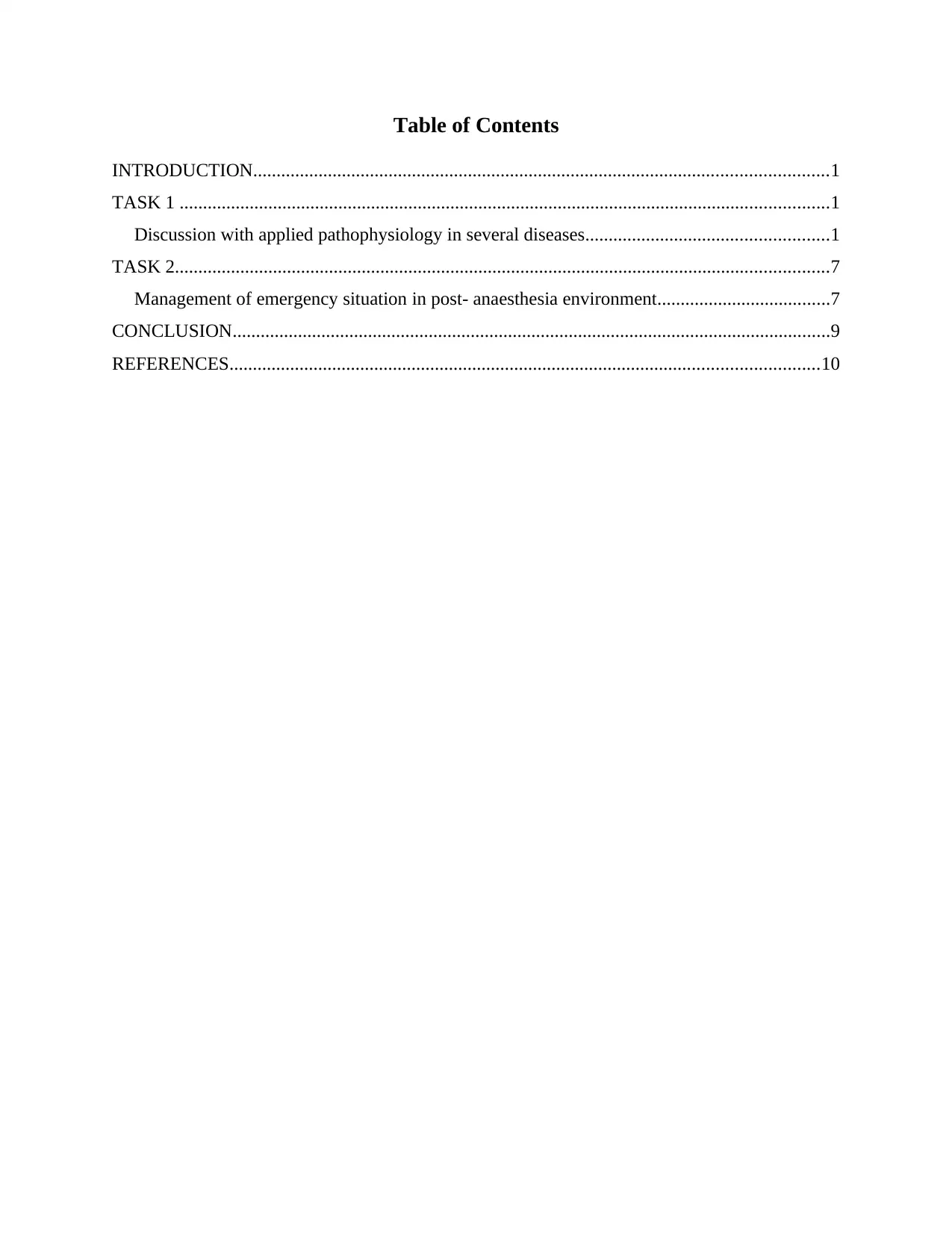
Table of Contents
INTRODUCTION...........................................................................................................................1
TASK 1 ...........................................................................................................................................1
Discussion with applied pathophysiology in several diseases....................................................1
TASK 2............................................................................................................................................7
Management of emergency situation in post- anaesthesia environment.....................................7
CONCLUSION................................................................................................................................9
REFERENCES..............................................................................................................................10
INTRODUCTION...........................................................................................................................1
TASK 1 ...........................................................................................................................................1
Discussion with applied pathophysiology in several diseases....................................................1
TASK 2............................................................................................................................................7
Management of emergency situation in post- anaesthesia environment.....................................7
CONCLUSION................................................................................................................................9
REFERENCES..............................................................................................................................10
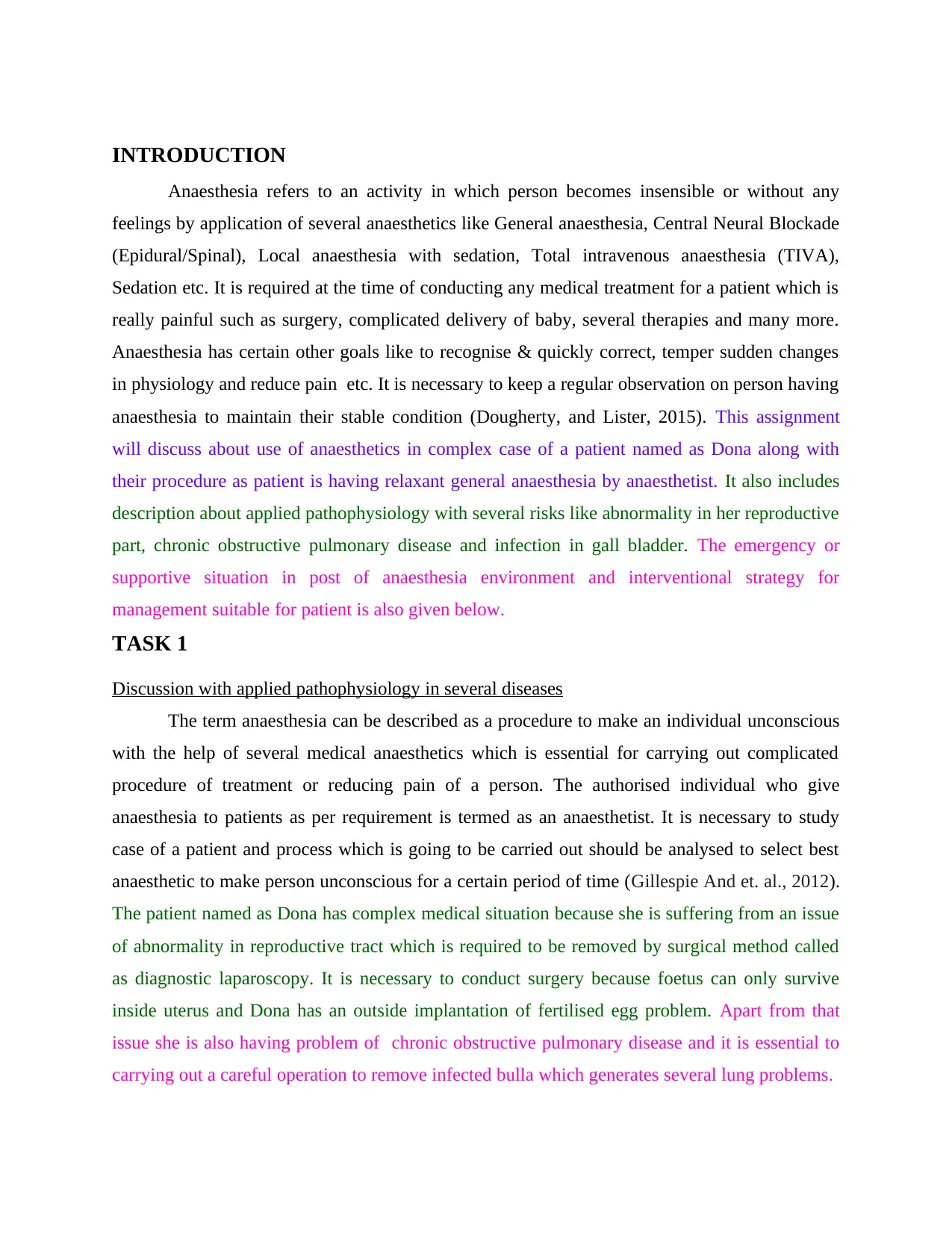
INTRODUCTION
Anaesthesia refers to an activity in which person becomes insensible or without any
feelings by application of several anaesthetics like General anaesthesia, Central Neural Blockade
(Epidural/Spinal), Local anaesthesia with sedation, Total intravenous anaesthesia (TIVA),
Sedation etc. It is required at the time of conducting any medical treatment for a patient which is
really painful such as surgery, complicated delivery of baby, several therapies and many more.
Anaesthesia has certain other goals like to recognise & quickly correct, temper sudden changes
in physiology and reduce pain etc. It is necessary to keep a regular observation on person having
anaesthesia to maintain their stable condition (Dougherty, and Lister, 2015). This assignment
will discuss about use of anaesthetics in complex case of a patient named as Dona along with
their procedure as patient is having relaxant general anaesthesia by anaesthetist. It also includes
description about applied pathophysiology with several risks like abnormality in her reproductive
part, chronic obstructive pulmonary disease and infection in gall bladder. The emergency or
supportive situation in post of anaesthesia environment and interventional strategy for
management suitable for patient is also given below.
TASK 1
Discussion with applied pathophysiology in several diseases
The term anaesthesia can be described as a procedure to make an individual unconscious
with the help of several medical anaesthetics which is essential for carrying out complicated
procedure of treatment or reducing pain of a person. The authorised individual who give
anaesthesia to patients as per requirement is termed as an anaesthetist. It is necessary to study
case of a patient and process which is going to be carried out should be analysed to select best
anaesthetic to make person unconscious for a certain period of time (Gillespie And et. al., 2012).
The patient named as Dona has complex medical situation because she is suffering from an issue
of abnormality in reproductive tract which is required to be removed by surgical method called
as diagnostic laparoscopy. It is necessary to conduct surgery because foetus can only survive
inside uterus and Dona has an outside implantation of fertilised egg problem. Apart from that
issue she is also having problem of chronic obstructive pulmonary disease and it is essential to
carrying out a careful operation to remove infected bulla which generates several lung problems.
Anaesthesia refers to an activity in which person becomes insensible or without any
feelings by application of several anaesthetics like General anaesthesia, Central Neural Blockade
(Epidural/Spinal), Local anaesthesia with sedation, Total intravenous anaesthesia (TIVA),
Sedation etc. It is required at the time of conducting any medical treatment for a patient which is
really painful such as surgery, complicated delivery of baby, several therapies and many more.
Anaesthesia has certain other goals like to recognise & quickly correct, temper sudden changes
in physiology and reduce pain etc. It is necessary to keep a regular observation on person having
anaesthesia to maintain their stable condition (Dougherty, and Lister, 2015). This assignment
will discuss about use of anaesthetics in complex case of a patient named as Dona along with
their procedure as patient is having relaxant general anaesthesia by anaesthetist. It also includes
description about applied pathophysiology with several risks like abnormality in her reproductive
part, chronic obstructive pulmonary disease and infection in gall bladder. The emergency or
supportive situation in post of anaesthesia environment and interventional strategy for
management suitable for patient is also given below.
TASK 1
Discussion with applied pathophysiology in several diseases
The term anaesthesia can be described as a procedure to make an individual unconscious
with the help of several medical anaesthetics which is essential for carrying out complicated
procedure of treatment or reducing pain of a person. The authorised individual who give
anaesthesia to patients as per requirement is termed as an anaesthetist. It is necessary to study
case of a patient and process which is going to be carried out should be analysed to select best
anaesthetic to make person unconscious for a certain period of time (Gillespie And et. al., 2012).
The patient named as Dona has complex medical situation because she is suffering from an issue
of abnormality in reproductive tract which is required to be removed by surgical method called
as diagnostic laparoscopy. It is necessary to conduct surgery because foetus can only survive
inside uterus and Dona has an outside implantation of fertilised egg problem. Apart from that
issue she is also having problem of chronic obstructive pulmonary disease and it is essential to
carrying out a careful operation to remove infected bulla which generates several lung problems.
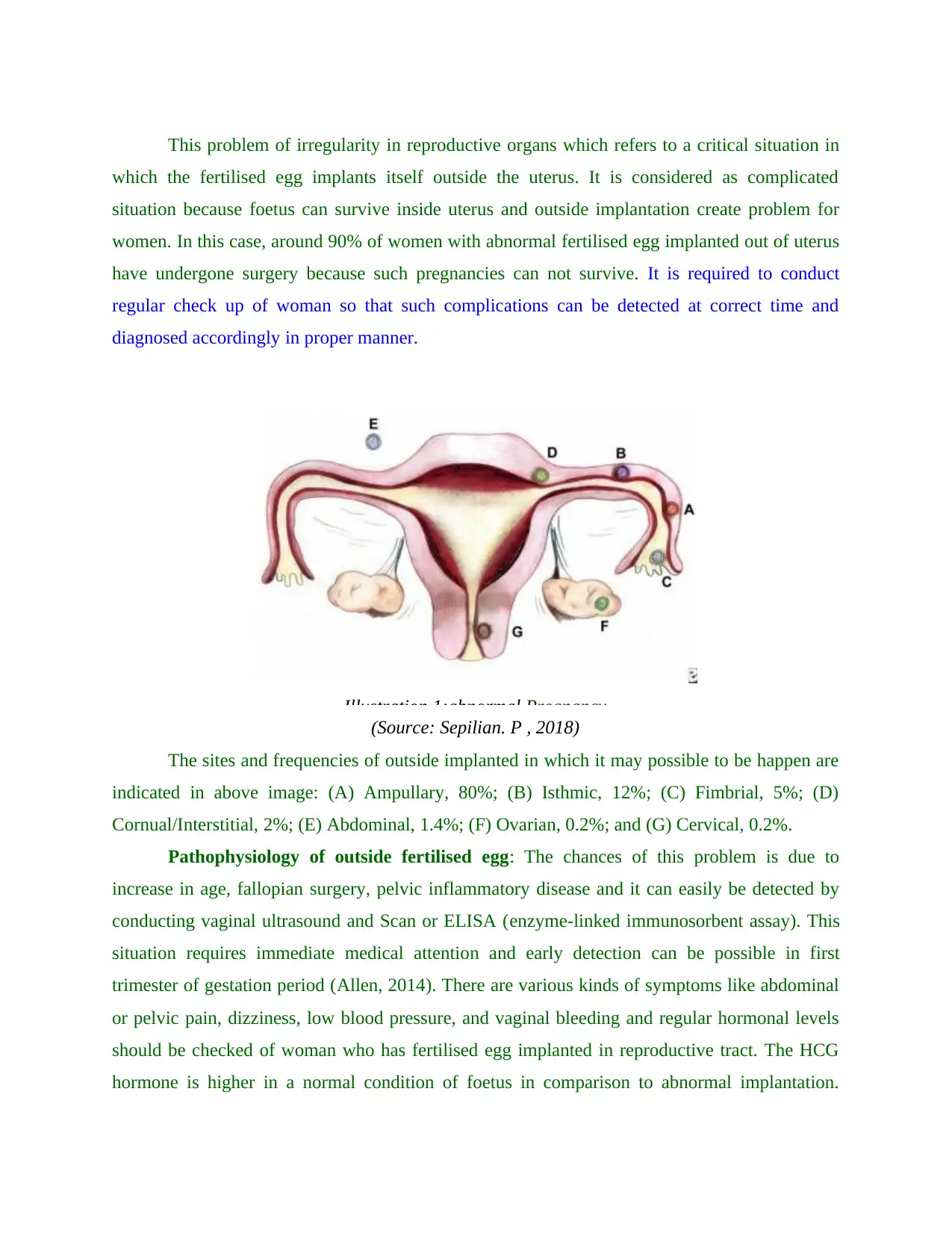
This problem of irregularity in reproductive organs which refers to a critical situation in
which the fertilised egg implants itself outside the uterus. It is considered as complicated
situation because foetus can survive inside uterus and outside implantation create problem for
women. In this case, around 90% of women with abnormal fertilised egg implanted out of uterus
have undergone surgery because such pregnancies can not survive. It is required to conduct
regular check up of woman so that such complications can be detected at correct time and
diagnosed accordingly in proper manner.
(Source: Sepilian. P , 2018)
The sites and frequencies of outside implanted in which it may possible to be happen are
indicated in above image: (A) Ampullary, 80%; (B) Isthmic, 12%; (C) Fimbrial, 5%; (D)
Cornual/Interstitial, 2%; (E) Abdominal, 1.4%; (F) Ovarian, 0.2%; and (G) Cervical, 0.2%.
Pathophysiology of outside fertilised egg: The chances of this problem is due to
increase in age, fallopian surgery, pelvic inflammatory disease and it can easily be detected by
conducting vaginal ultrasound and Scan or ELISA (enzyme-linked immunosorbent assay). This
situation requires immediate medical attention and early detection can be possible in first
trimester of gestation period (Allen, 2014). There are various kinds of symptoms like abdominal
or pelvic pain, dizziness, low blood pressure, and vaginal bleeding and regular hormonal levels
should be checked of woman who has fertilised egg implanted in reproductive tract. The HCG
hormone is higher in a normal condition of foetus in comparison to abnormal implantation.
Illustration 1:abnormal Pregnancy
which the fertilised egg implants itself outside the uterus. It is considered as complicated
situation because foetus can survive inside uterus and outside implantation create problem for
women. In this case, around 90% of women with abnormal fertilised egg implanted out of uterus
have undergone surgery because such pregnancies can not survive. It is required to conduct
regular check up of woman so that such complications can be detected at correct time and
diagnosed accordingly in proper manner.
(Source: Sepilian. P , 2018)
The sites and frequencies of outside implanted in which it may possible to be happen are
indicated in above image: (A) Ampullary, 80%; (B) Isthmic, 12%; (C) Fimbrial, 5%; (D)
Cornual/Interstitial, 2%; (E) Abdominal, 1.4%; (F) Ovarian, 0.2%; and (G) Cervical, 0.2%.
Pathophysiology of outside fertilised egg: The chances of this problem is due to
increase in age, fallopian surgery, pelvic inflammatory disease and it can easily be detected by
conducting vaginal ultrasound and Scan or ELISA (enzyme-linked immunosorbent assay). This
situation requires immediate medical attention and early detection can be possible in first
trimester of gestation period (Allen, 2014). There are various kinds of symptoms like abdominal
or pelvic pain, dizziness, low blood pressure, and vaginal bleeding and regular hormonal levels
should be checked of woman who has fertilised egg implanted in reproductive tract. The HCG
hormone is higher in a normal condition of foetus in comparison to abnormal implantation.
Illustration 1:abnormal Pregnancy
Secure Best Marks with AI Grader
Need help grading? Try our AI Grader for instant feedback on your assignments.
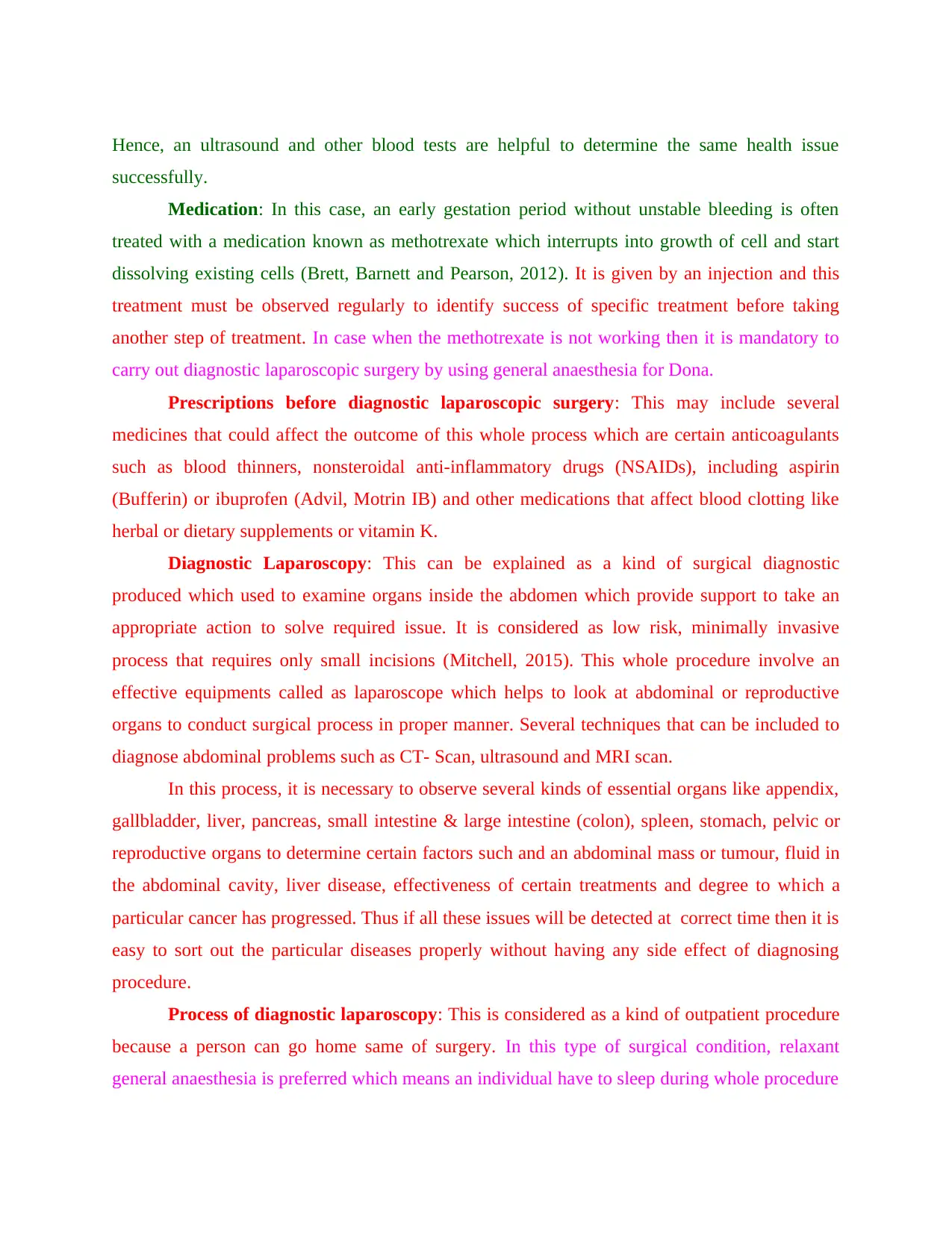
Hence, an ultrasound and other blood tests are helpful to determine the same health issue
successfully.
Medication: In this case, an early gestation period without unstable bleeding is often
treated with a medication known as methotrexate which interrupts into growth of cell and start
dissolving existing cells (Brett, Barnett and Pearson, 2012). It is given by an injection and this
treatment must be observed regularly to identify success of specific treatment before taking
another step of treatment. In case when the methotrexate is not working then it is mandatory to
carry out diagnostic laparoscopic surgery by using general anaesthesia for Dona.
Prescriptions before diagnostic laparoscopic surgery: This may include several
medicines that could affect the outcome of this whole process which are certain anticoagulants
such as blood thinners, nonsteroidal anti-inflammatory drugs (NSAIDs), including aspirin
(Bufferin) or ibuprofen (Advil, Motrin IB) and other medications that affect blood clotting like
herbal or dietary supplements or vitamin K.
Diagnostic Laparoscopy: This can be explained as a kind of surgical diagnostic
produced which used to examine organs inside the abdomen which provide support to take an
appropriate action to solve required issue. It is considered as low risk, minimally invasive
process that requires only small incisions (Mitchell, 2015). This whole procedure involve an
effective equipments called as laparoscope which helps to look at abdominal or reproductive
organs to conduct surgical process in proper manner. Several techniques that can be included to
diagnose abdominal problems such as CT- Scan, ultrasound and MRI scan.
In this process, it is necessary to observe several kinds of essential organs like appendix,
gallbladder, liver, pancreas, small intestine & large intestine (colon), spleen, stomach, pelvic or
reproductive organs to determine certain factors such and an abdominal mass or tumour, fluid in
the abdominal cavity, liver disease, effectiveness of certain treatments and degree to which a
particular cancer has progressed. Thus if all these issues will be detected at correct time then it is
easy to sort out the particular diseases properly without having any side effect of diagnosing
procedure.
Process of diagnostic laparoscopy: This is considered as a kind of outpatient procedure
because a person can go home same of surgery. In this type of surgical condition, relaxant
general anaesthesia is preferred which means an individual have to sleep during whole procedure
successfully.
Medication: In this case, an early gestation period without unstable bleeding is often
treated with a medication known as methotrexate which interrupts into growth of cell and start
dissolving existing cells (Brett, Barnett and Pearson, 2012). It is given by an injection and this
treatment must be observed regularly to identify success of specific treatment before taking
another step of treatment. In case when the methotrexate is not working then it is mandatory to
carry out diagnostic laparoscopic surgery by using general anaesthesia for Dona.
Prescriptions before diagnostic laparoscopic surgery: This may include several
medicines that could affect the outcome of this whole process which are certain anticoagulants
such as blood thinners, nonsteroidal anti-inflammatory drugs (NSAIDs), including aspirin
(Bufferin) or ibuprofen (Advil, Motrin IB) and other medications that affect blood clotting like
herbal or dietary supplements or vitamin K.
Diagnostic Laparoscopy: This can be explained as a kind of surgical diagnostic
produced which used to examine organs inside the abdomen which provide support to take an
appropriate action to solve required issue. It is considered as low risk, minimally invasive
process that requires only small incisions (Mitchell, 2015). This whole procedure involve an
effective equipments called as laparoscope which helps to look at abdominal or reproductive
organs to conduct surgical process in proper manner. Several techniques that can be included to
diagnose abdominal problems such as CT- Scan, ultrasound and MRI scan.
In this process, it is necessary to observe several kinds of essential organs like appendix,
gallbladder, liver, pancreas, small intestine & large intestine (colon), spleen, stomach, pelvic or
reproductive organs to determine certain factors such and an abdominal mass or tumour, fluid in
the abdominal cavity, liver disease, effectiveness of certain treatments and degree to which a
particular cancer has progressed. Thus if all these issues will be detected at correct time then it is
easy to sort out the particular diseases properly without having any side effect of diagnosing
procedure.
Process of diagnostic laparoscopy: This is considered as a kind of outpatient procedure
because a person can go home same of surgery. In this type of surgical condition, relaxant
general anaesthesia is preferred which means an individual have to sleep during whole procedure
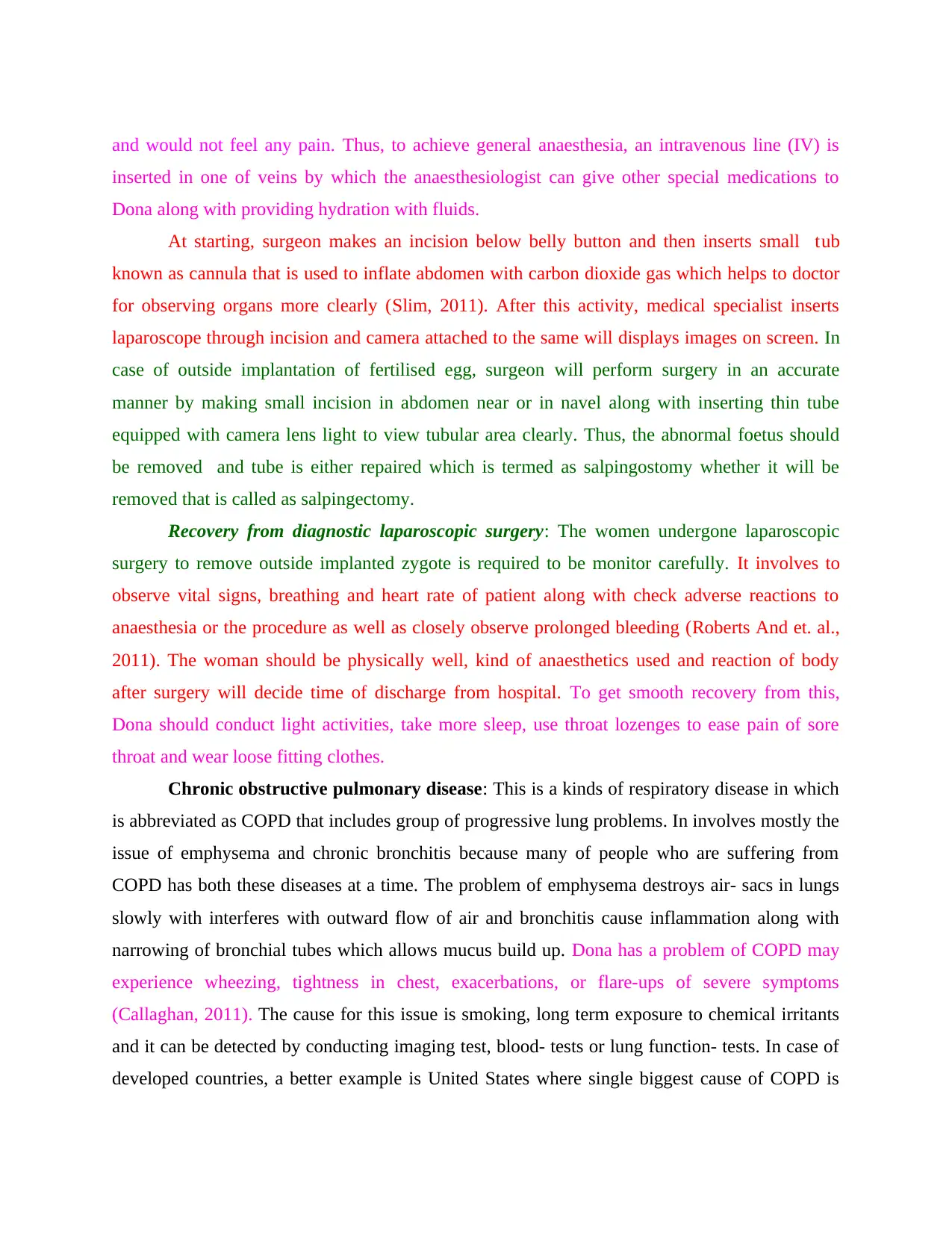
and would not feel any pain. Thus, to achieve general anaesthesia, an intravenous line (IV) is
inserted in one of veins by which the anaesthesiologist can give other special medications to
Dona along with providing hydration with fluids.
At starting, surgeon makes an incision below belly button and then inserts small tub
known as cannula that is used to inflate abdomen with carbon dioxide gas which helps to doctor
for observing organs more clearly (Slim, 2011). After this activity, medical specialist inserts
laparoscope through incision and camera attached to the same will displays images on screen. In
case of outside implantation of fertilised egg, surgeon will perform surgery in an accurate
manner by making small incision in abdomen near or in navel along with inserting thin tube
equipped with camera lens light to view tubular area clearly. Thus, the abnormal foetus should
be removed and tube is either repaired which is termed as salpingostomy whether it will be
removed that is called as salpingectomy.
Recovery from diagnostic laparoscopic surgery: The women undergone laparoscopic
surgery to remove outside implanted zygote is required to be monitor carefully. It involves to
observe vital signs, breathing and heart rate of patient along with check adverse reactions to
anaesthesia or the procedure as well as closely observe prolonged bleeding (Roberts And et. al.,
2011). The woman should be physically well, kind of anaesthetics used and reaction of body
after surgery will decide time of discharge from hospital. To get smooth recovery from this,
Dona should conduct light activities, take more sleep, use throat lozenges to ease pain of sore
throat and wear loose fitting clothes.
Chronic obstructive pulmonary disease: This is a kinds of respiratory disease in which
is abbreviated as COPD that includes group of progressive lung problems. In involves mostly the
issue of emphysema and chronic bronchitis because many of people who are suffering from
COPD has both these diseases at a time. The problem of emphysema destroys air- sacs in lungs
slowly with interferes with outward flow of air and bronchitis cause inflammation along with
narrowing of bronchial tubes which allows mucus build up. Dona has a problem of COPD may
experience wheezing, tightness in chest, exacerbations, or flare-ups of severe symptoms
(Callaghan, 2011). The cause for this issue is smoking, long term exposure to chemical irritants
and it can be detected by conducting imaging test, blood- tests or lung function- tests. In case of
developed countries, a better example is United States where single biggest cause of COPD is
inserted in one of veins by which the anaesthesiologist can give other special medications to
Dona along with providing hydration with fluids.
At starting, surgeon makes an incision below belly button and then inserts small tub
known as cannula that is used to inflate abdomen with carbon dioxide gas which helps to doctor
for observing organs more clearly (Slim, 2011). After this activity, medical specialist inserts
laparoscope through incision and camera attached to the same will displays images on screen. In
case of outside implantation of fertilised egg, surgeon will perform surgery in an accurate
manner by making small incision in abdomen near or in navel along with inserting thin tube
equipped with camera lens light to view tubular area clearly. Thus, the abnormal foetus should
be removed and tube is either repaired which is termed as salpingostomy whether it will be
removed that is called as salpingectomy.
Recovery from diagnostic laparoscopic surgery: The women undergone laparoscopic
surgery to remove outside implanted zygote is required to be monitor carefully. It involves to
observe vital signs, breathing and heart rate of patient along with check adverse reactions to
anaesthesia or the procedure as well as closely observe prolonged bleeding (Roberts And et. al.,
2011). The woman should be physically well, kind of anaesthetics used and reaction of body
after surgery will decide time of discharge from hospital. To get smooth recovery from this,
Dona should conduct light activities, take more sleep, use throat lozenges to ease pain of sore
throat and wear loose fitting clothes.
Chronic obstructive pulmonary disease: This is a kinds of respiratory disease in which
is abbreviated as COPD that includes group of progressive lung problems. In involves mostly the
issue of emphysema and chronic bronchitis because many of people who are suffering from
COPD has both these diseases at a time. The problem of emphysema destroys air- sacs in lungs
slowly with interferes with outward flow of air and bronchitis cause inflammation along with
narrowing of bronchial tubes which allows mucus build up. Dona has a problem of COPD may
experience wheezing, tightness in chest, exacerbations, or flare-ups of severe symptoms
(Callaghan, 2011). The cause for this issue is smoking, long term exposure to chemical irritants
and it can be detected by conducting imaging test, blood- tests or lung function- tests. In case of
developed countries, a better example is United States where single biggest cause of COPD is

Cigarette smoking. Thus, around 90 percent of people having this problem are smokers or
former smokers.
Pathophysiology of Chronic obstructive pulmonary disease: The chronic obstructive
pulmonary disease can be diagnosed by several pathological tests like blood- test and lung
function- test. In case of COPD, air sacs have lost their stretchiness, walls between air sacs are
damaged, airways become inflamed & thickened and more mucus is produced in airways which
causing them to clog. There are various symptoms which indicates about this problem such as
occasional shortness of breath, especially after exercise, mild but recurrent cough and need to
clear throat often, especially first thing in the morning. Some of signs that are progressively
worse and harder to ignore such as shortness of breath, after even mild exercise such as walking
up a flight of stairs, wheezing or noisy breathing, chest tightness, chronic cough- with or without
mucus, need to clear mucus from lungs every day, frequent colds, flu, or other respiratory
infections and lack of energy. Various kinds of critical evidences which are generally observed
in later stages of COPD are fatigue, swelling of the feet, ankles, or legs and weight loss . But a
person requires immediate treatment while certain factors are observed like bluish or grey
fingernails or lips which indicates low oxygen levels in blood, trouble catching breath or cannot
talk, feel confused, muddled, or faint etc.
(Source: Chronic obstructive pulmonary disease, 2018)
Illustration 2: Chronic obstructive pulmonary
disease
former smokers.
Pathophysiology of Chronic obstructive pulmonary disease: The chronic obstructive
pulmonary disease can be diagnosed by several pathological tests like blood- test and lung
function- test. In case of COPD, air sacs have lost their stretchiness, walls between air sacs are
damaged, airways become inflamed & thickened and more mucus is produced in airways which
causing them to clog. There are various symptoms which indicates about this problem such as
occasional shortness of breath, especially after exercise, mild but recurrent cough and need to
clear throat often, especially first thing in the morning. Some of signs that are progressively
worse and harder to ignore such as shortness of breath, after even mild exercise such as walking
up a flight of stairs, wheezing or noisy breathing, chest tightness, chronic cough- with or without
mucus, need to clear mucus from lungs every day, frequent colds, flu, or other respiratory
infections and lack of energy. Various kinds of critical evidences which are generally observed
in later stages of COPD are fatigue, swelling of the feet, ankles, or legs and weight loss . But a
person requires immediate treatment while certain factors are observed like bluish or grey
fingernails or lips which indicates low oxygen levels in blood, trouble catching breath or cannot
talk, feel confused, muddled, or faint etc.
(Source: Chronic obstructive pulmonary disease, 2018)
Illustration 2: Chronic obstructive pulmonary
disease
Paraphrase This Document
Need a fresh take? Get an instant paraphrase of this document with our AI Paraphraser
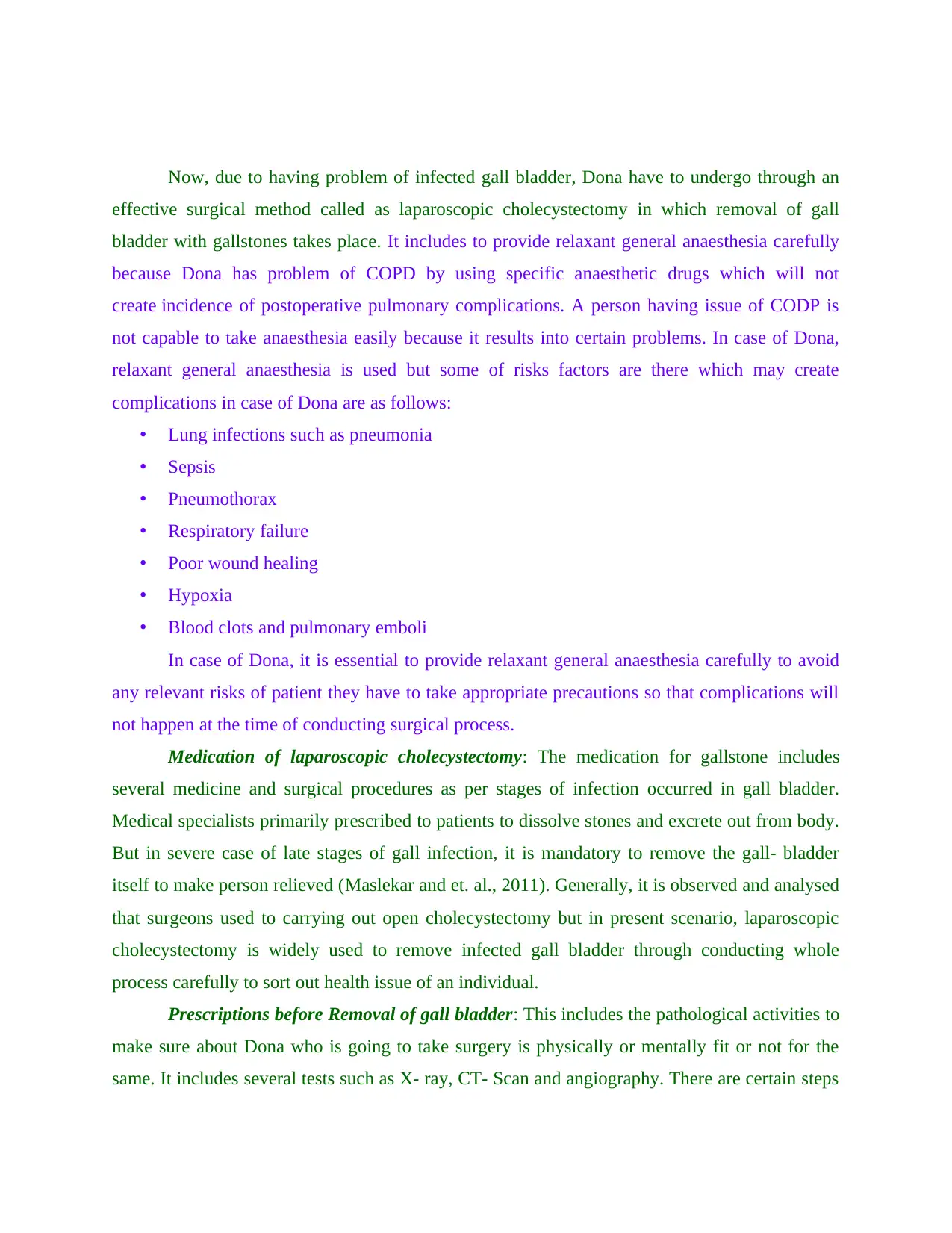
Now, due to having problem of infected gall bladder, Dona have to undergo through an
effective surgical method called as laparoscopic cholecystectomy in which removal of gall
bladder with gallstones takes place. It includes to provide relaxant general anaesthesia carefully
because Dona has problem of COPD by using specific anaesthetic drugs which will not
create incidence of postoperative pulmonary complications. A person having issue of CODP is
not capable to take anaesthesia easily because it results into certain problems. In case of Dona,
relaxant general anaesthesia is used but some of risks factors are there which may create
complications in case of Dona are as follows:
• Lung infections such as pneumonia
• Sepsis
• Pneumothorax
• Respiratory failure
• Poor wound healing
• Hypoxia
• Blood clots and pulmonary emboli
In case of Dona, it is essential to provide relaxant general anaesthesia carefully to avoid
any relevant risks of patient they have to take appropriate precautions so that complications will
not happen at the time of conducting surgical process.
Medication of laparoscopic cholecystectomy: The medication for gallstone includes
several medicine and surgical procedures as per stages of infection occurred in gall bladder.
Medical specialists primarily prescribed to patients to dissolve stones and excrete out from body.
But in severe case of late stages of gall infection, it is mandatory to remove the gall- bladder
itself to make person relieved (Maslekar and et. al., 2011). Generally, it is observed and analysed
that surgeons used to carrying out open cholecystectomy but in present scenario, laparoscopic
cholecystectomy is widely used to remove infected gall bladder through conducting whole
process carefully to sort out health issue of an individual.
Prescriptions before Removal of gall bladder: This includes the pathological activities to
make sure about Dona who is going to take surgery is physically or mentally fit or not for the
same. It includes several tests such as X- ray, CT- Scan and angiography. There are certain steps
effective surgical method called as laparoscopic cholecystectomy in which removal of gall
bladder with gallstones takes place. It includes to provide relaxant general anaesthesia carefully
because Dona has problem of COPD by using specific anaesthetic drugs which will not
create incidence of postoperative pulmonary complications. A person having issue of CODP is
not capable to take anaesthesia easily because it results into certain problems. In case of Dona,
relaxant general anaesthesia is used but some of risks factors are there which may create
complications in case of Dona are as follows:
• Lung infections such as pneumonia
• Sepsis
• Pneumothorax
• Respiratory failure
• Poor wound healing
• Hypoxia
• Blood clots and pulmonary emboli
In case of Dona, it is essential to provide relaxant general anaesthesia carefully to avoid
any relevant risks of patient they have to take appropriate precautions so that complications will
not happen at the time of conducting surgical process.
Medication of laparoscopic cholecystectomy: The medication for gallstone includes
several medicine and surgical procedures as per stages of infection occurred in gall bladder.
Medical specialists primarily prescribed to patients to dissolve stones and excrete out from body.
But in severe case of late stages of gall infection, it is mandatory to remove the gall- bladder
itself to make person relieved (Maslekar and et. al., 2011). Generally, it is observed and analysed
that surgeons used to carrying out open cholecystectomy but in present scenario, laparoscopic
cholecystectomy is widely used to remove infected gall bladder through conducting whole
process carefully to sort out health issue of an individual.
Prescriptions before Removal of gall bladder: This includes the pathological activities to
make sure about Dona who is going to take surgery is physically or mentally fit or not for the
same. It includes several tests such as X- ray, CT- Scan and angiography. There are certain steps
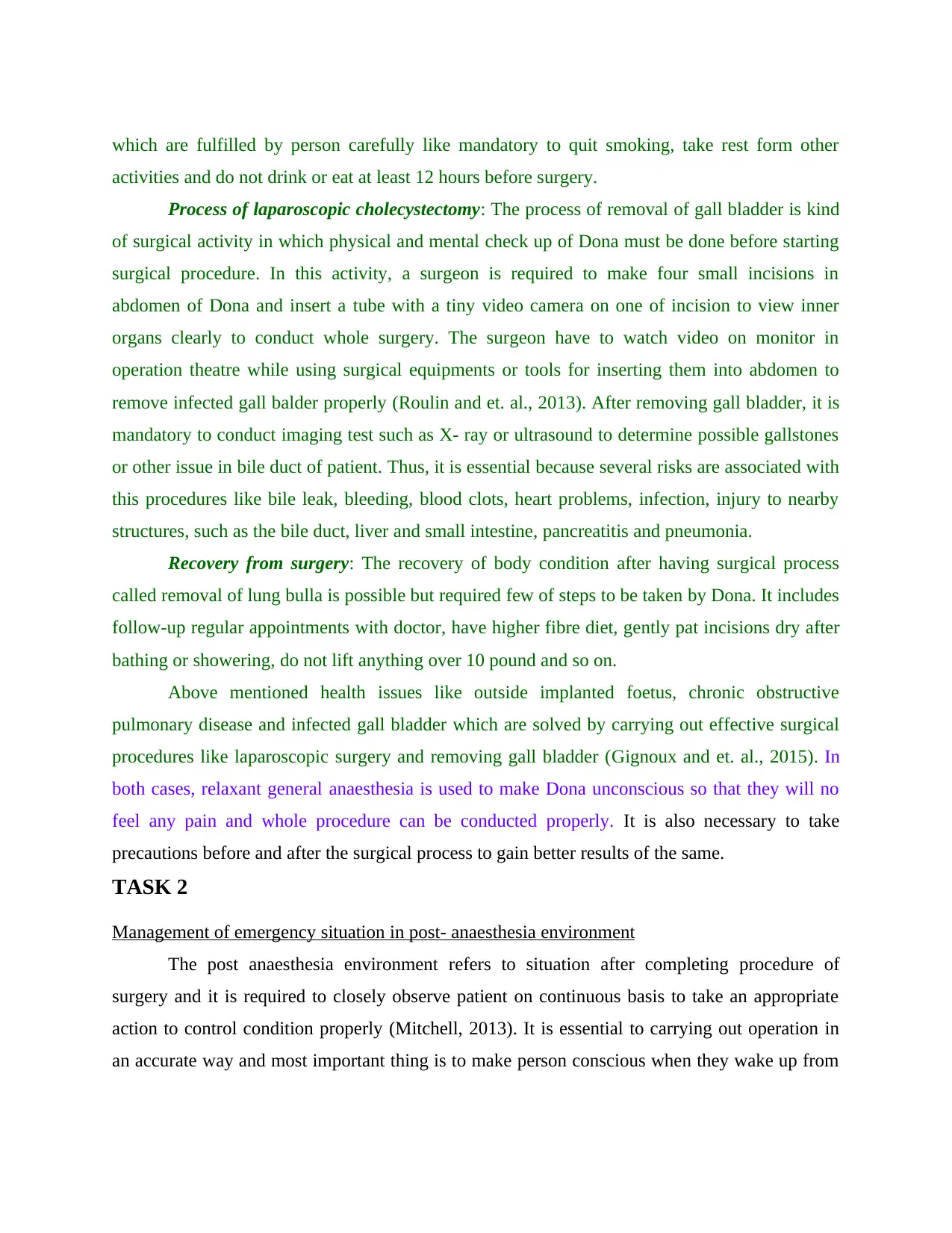
which are fulfilled by person carefully like mandatory to quit smoking, take rest form other
activities and do not drink or eat at least 12 hours before surgery.
Process of laparoscopic cholecystectomy: The process of removal of gall bladder is kind
of surgical activity in which physical and mental check up of Dona must be done before starting
surgical procedure. In this activity, a surgeon is required to make four small incisions in
abdomen of Dona and insert a tube with a tiny video camera on one of incision to view inner
organs clearly to conduct whole surgery. The surgeon have to watch video on monitor in
operation theatre while using surgical equipments or tools for inserting them into abdomen to
remove infected gall balder properly (Roulin and et. al., 2013). After removing gall bladder, it is
mandatory to conduct imaging test such as X- ray or ultrasound to determine possible gallstones
or other issue in bile duct of patient. Thus, it is essential because several risks are associated with
this procedures like bile leak, bleeding, blood clots, heart problems, infection, injury to nearby
structures, such as the bile duct, liver and small intestine, pancreatitis and pneumonia.
Recovery from surgery: The recovery of body condition after having surgical process
called removal of lung bulla is possible but required few of steps to be taken by Dona. It includes
follow-up regular appointments with doctor, have higher fibre diet, gently pat incisions dry after
bathing or showering, do not lift anything over 10 pound and so on.
Above mentioned health issues like outside implanted foetus, chronic obstructive
pulmonary disease and infected gall bladder which are solved by carrying out effective surgical
procedures like laparoscopic surgery and removing gall bladder (Gignoux and et. al., 2015). In
both cases, relaxant general anaesthesia is used to make Dona unconscious so that they will no
feel any pain and whole procedure can be conducted properly. It is also necessary to take
precautions before and after the surgical process to gain better results of the same.
TASK 2
Management of emergency situation in post- anaesthesia environment
The post anaesthesia environment refers to situation after completing procedure of
surgery and it is required to closely observe patient on continuous basis to take an appropriate
action to control condition properly (Mitchell, 2013). It is essential to carrying out operation in
an accurate way and most important thing is to make person conscious when they wake up from
activities and do not drink or eat at least 12 hours before surgery.
Process of laparoscopic cholecystectomy: The process of removal of gall bladder is kind
of surgical activity in which physical and mental check up of Dona must be done before starting
surgical procedure. In this activity, a surgeon is required to make four small incisions in
abdomen of Dona and insert a tube with a tiny video camera on one of incision to view inner
organs clearly to conduct whole surgery. The surgeon have to watch video on monitor in
operation theatre while using surgical equipments or tools for inserting them into abdomen to
remove infected gall balder properly (Roulin and et. al., 2013). After removing gall bladder, it is
mandatory to conduct imaging test such as X- ray or ultrasound to determine possible gallstones
or other issue in bile duct of patient. Thus, it is essential because several risks are associated with
this procedures like bile leak, bleeding, blood clots, heart problems, infection, injury to nearby
structures, such as the bile duct, liver and small intestine, pancreatitis and pneumonia.
Recovery from surgery: The recovery of body condition after having surgical process
called removal of lung bulla is possible but required few of steps to be taken by Dona. It includes
follow-up regular appointments with doctor, have higher fibre diet, gently pat incisions dry after
bathing or showering, do not lift anything over 10 pound and so on.
Above mentioned health issues like outside implanted foetus, chronic obstructive
pulmonary disease and infected gall bladder which are solved by carrying out effective surgical
procedures like laparoscopic surgery and removing gall bladder (Gignoux and et. al., 2015). In
both cases, relaxant general anaesthesia is used to make Dona unconscious so that they will no
feel any pain and whole procedure can be conducted properly. It is also necessary to take
precautions before and after the surgical process to gain better results of the same.
TASK 2
Management of emergency situation in post- anaesthesia environment
The post anaesthesia environment refers to situation after completing procedure of
surgery and it is required to closely observe patient on continuous basis to take an appropriate
action to control condition properly (Mitchell, 2013). It is essential to carrying out operation in
an accurate way and most important thing is to make person conscious when they wake up from

anaesthesia. There are various kinds of management strategies which are applicable in different
emergency situations to deal with complications and maintain stable condition of patient
successfully. Post surgical situation is also crucial till that time when a person wakes up with
normal consciousness and respond in positive manner form anaesthetic situation. Thus, actual
results of carried out surgery are dependent on reactions of patient which are observed by
medical professionals ion regular basis by keeping them under observation for at least 24 hours.
The intervention strategies should be used by specialise while conducting while surgical
process and after completing the same because condition of person can be considered as stable
when they response positively by waking up from anaesthesia. It is essential to carefully taken
several steps by staff members of health care organisation to get an appropriate results. In case of
any facing Airway obstruction by a patient in post surgery environment then an emergency
situation raised which can be avoided by several methods that are explained further-
Extubation strategy: This can be described as an effective as well as efficient action
which includes the surgical process itself to be carried out in an appropriate manner. It is
essential to carefully conduct very single step in procedure of operation because a minor mistake
of surgeon may leads to critical situation or even death of the person. There are various kinds of
cases seen in which a little error in surgical process may results into death of patients. It includes
several anatomical and physiological changes of body which may negative or positive.
Extubation involves technique to solve post complications by removing endotracheal tube.
Aid risk stratification: The term aid risk stratification includes to select favourable
method of surgery by keeping in mind about preferences of patient because mentally
consciousness of person impacts on reactions of body in post anaesthesia environment. It is all
about to study and check response of body in an accurate way and then select more suitable
techniques to carrying out operation which can be easily accepts by body of patient. Thus, it will
facilitate to reduce risks of complication and provide better results of the same.
Practical management of routine: This can be described as to make an appropriate
strategy to carrying out regular activities which are helpful to provide medical facilities to person
in correct manner. It includes to conduct regular checks ups of blood pressures, temperature heart
rate and other various functions so that patient will remain conscious during process of surgery.
emergency situations to deal with complications and maintain stable condition of patient
successfully. Post surgical situation is also crucial till that time when a person wakes up with
normal consciousness and respond in positive manner form anaesthetic situation. Thus, actual
results of carried out surgery are dependent on reactions of patient which are observed by
medical professionals ion regular basis by keeping them under observation for at least 24 hours.
The intervention strategies should be used by specialise while conducting while surgical
process and after completing the same because condition of person can be considered as stable
when they response positively by waking up from anaesthesia. It is essential to carefully taken
several steps by staff members of health care organisation to get an appropriate results. In case of
any facing Airway obstruction by a patient in post surgery environment then an emergency
situation raised which can be avoided by several methods that are explained further-
Extubation strategy: This can be described as an effective as well as efficient action
which includes the surgical process itself to be carried out in an appropriate manner. It is
essential to carefully conduct very single step in procedure of operation because a minor mistake
of surgeon may leads to critical situation or even death of the person. There are various kinds of
cases seen in which a little error in surgical process may results into death of patients. It includes
several anatomical and physiological changes of body which may negative or positive.
Extubation involves technique to solve post complications by removing endotracheal tube.
Aid risk stratification: The term aid risk stratification includes to select favourable
method of surgery by keeping in mind about preferences of patient because mentally
consciousness of person impacts on reactions of body in post anaesthesia environment. It is all
about to study and check response of body in an accurate way and then select more suitable
techniques to carrying out operation which can be easily accepts by body of patient. Thus, it will
facilitate to reduce risks of complication and provide better results of the same.
Practical management of routine: This can be described as to make an appropriate
strategy to carrying out regular activities which are helpful to provide medical facilities to person
in correct manner. It includes to conduct regular checks ups of blood pressures, temperature heart
rate and other various functions so that patient will remain conscious during process of surgery.
Secure Best Marks with AI Grader
Need help grading? Try our AI Grader for instant feedback on your assignments.

Postextubation care: In case of post emergency situation of Air Obstruction which
facing by an individual and it is observed that they have problem of laryngeal spasm from 1 hour
and stridor for as long 24 hours which is considered as post extubation. It is essential to evaluate
patient frequently in terms of work of breathing , respiratory rate, use of accessory muscles and
breathe sounds properly (Guo, 2015). The process of titrate the Fi02 for maintaining
Sp02>/=90%, begin incentive spirometry, flutter valve and HHN treatments with EZPap which
render support to make situation of patient favourable in proper manner.
Above mentioned factors or steps are helpful to gain indications of regular observing
patients who has undergone critical process of surgery to attain positive response from body of
them. It is necessary to carrying out whole surgical procedure in more appropriate manner to sort
out health problem like abnormal pregnancy and COPD by surgical methods like laparoscopic
surgery and Removal of lung bulla.
CONCLUSION
The above report had concluded that anaesthesia can be explained as an activity in which
person will make insensible or without feeling by the help of several anaesthetics like General
anaesthesia, Central Neural Blockade, Local anaesthesia with sedation and many more. It is
necessary to study case of an patient and process which going to be carried out should be
analysed to select best anaesthetic to make person unconscious for a certain period of time. The
procedure involve an effective equipments called as laparoscope which help to look at abdominal
organs to conduct surgical process in proper manner. The problem of emphysema destroys air-
sacs in lungs slowly with interferes with outward flow of air and bronchitis cause inflammation
along with narrowing of bronchial tubes which allows mucus build up. Removal of lung bulla
can be described as a kind of surgery to remove large areas of air sacs in lungs that combine to
form larger spaces within pleural cavity in lungs and solve problem of COPD.
facing by an individual and it is observed that they have problem of laryngeal spasm from 1 hour
and stridor for as long 24 hours which is considered as post extubation. It is essential to evaluate
patient frequently in terms of work of breathing , respiratory rate, use of accessory muscles and
breathe sounds properly (Guo, 2015). The process of titrate the Fi02 for maintaining
Sp02>/=90%, begin incentive spirometry, flutter valve and HHN treatments with EZPap which
render support to make situation of patient favourable in proper manner.
Above mentioned factors or steps are helpful to gain indications of regular observing
patients who has undergone critical process of surgery to attain positive response from body of
them. It is necessary to carrying out whole surgical procedure in more appropriate manner to sort
out health problem like abnormal pregnancy and COPD by surgical methods like laparoscopic
surgery and Removal of lung bulla.
CONCLUSION
The above report had concluded that anaesthesia can be explained as an activity in which
person will make insensible or without feeling by the help of several anaesthetics like General
anaesthesia, Central Neural Blockade, Local anaesthesia with sedation and many more. It is
necessary to study case of an patient and process which going to be carried out should be
analysed to select best anaesthetic to make person unconscious for a certain period of time. The
procedure involve an effective equipments called as laparoscope which help to look at abdominal
organs to conduct surgical process in proper manner. The problem of emphysema destroys air-
sacs in lungs slowly with interferes with outward flow of air and bronchitis cause inflammation
along with narrowing of bronchial tubes which allows mucus build up. Removal of lung bulla
can be described as a kind of surgery to remove large areas of air sacs in lungs that combine to
form larger spaces within pleural cavity in lungs and solve problem of COPD.
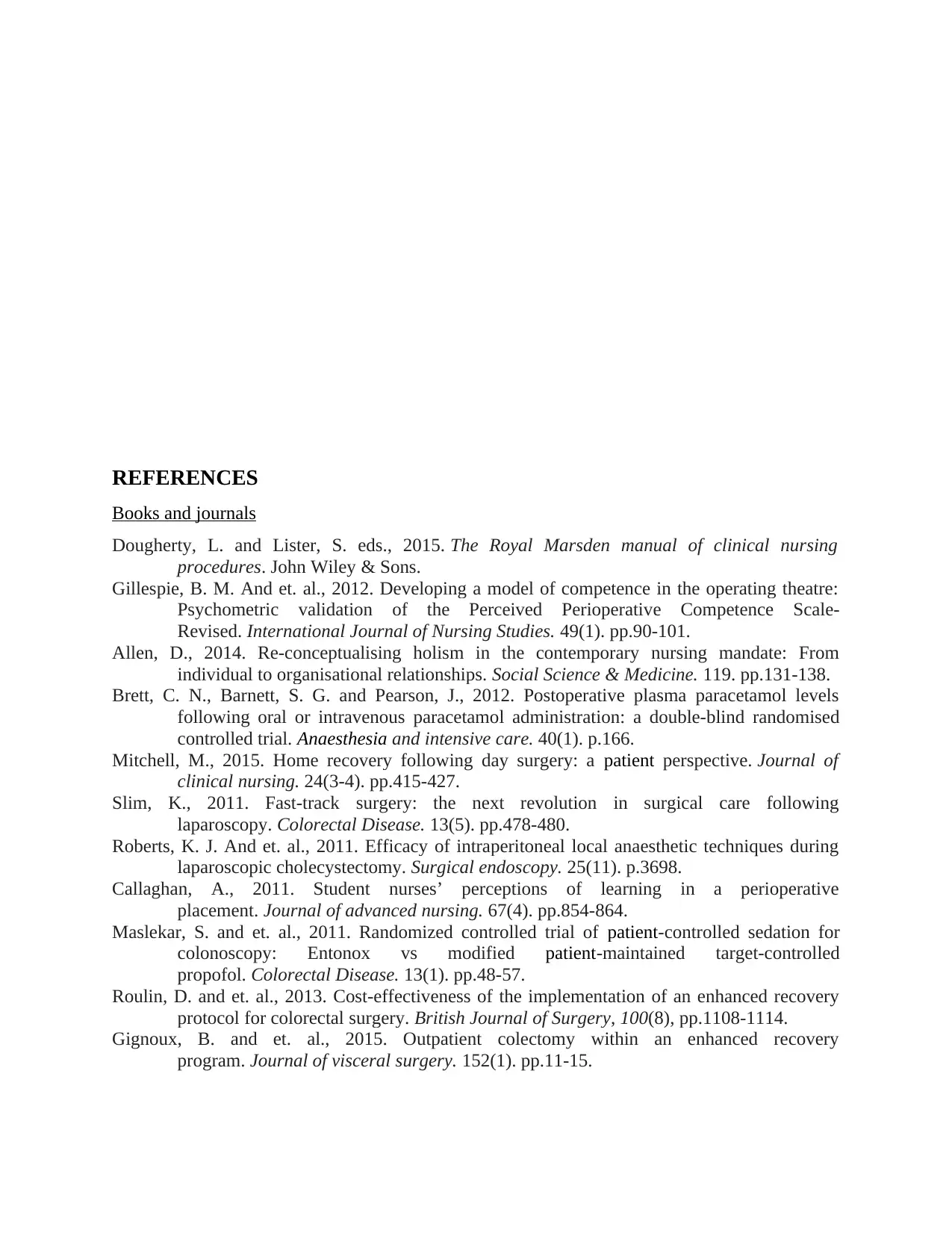
REFERENCES
Books and journals
Dougherty, L. and Lister, S. eds., 2015. The Royal Marsden manual of clinical nursing
procedures. John Wiley & Sons.
Gillespie, B. M. And et. al., 2012. Developing a model of competence in the operating theatre:
Psychometric validation of the Perceived Perioperative Competence Scale-
Revised. International Journal of Nursing Studies. 49(1). pp.90-101.
Allen, D., 2014. Re-conceptualising holism in the contemporary nursing mandate: From
individual to organisational relationships. Social Science & Medicine. 119. pp.131-138.
Brett, C. N., Barnett, S. G. and Pearson, J., 2012. Postoperative plasma paracetamol levels
following oral or intravenous paracetamol administration: a double-blind randomised
controlled trial. Anaesthesia and intensive care. 40(1). p.166.
Mitchell, M., 2015. Home recovery following day surgery: a patient perspective. Journal of
clinical nursing. 24(3-4). pp.415-427.
Slim, K., 2011. Fast‐track surgery: the next revolution in surgical care following
laparoscopy. Colorectal Disease. 13(5). pp.478-480.
Roberts, K. J. And et. al., 2011. Efficacy of intraperitoneal local anaesthetic techniques during
laparoscopic cholecystectomy. Surgical endoscopy. 25(11). p.3698.
Callaghan, A., 2011. Student nurses’ perceptions of learning in a perioperative
placement. Journal of advanced nursing. 67(4). pp.854-864.
Maslekar, S. and et. al., 2011. Randomized controlled trial of patient‐controlled sedation for
colonoscopy: Entonox vs modified patient‐maintained target‐controlled
propofol. Colorectal Disease. 13(1). pp.48-57.
Roulin, D. and et. al., 2013. Cost‐effectiveness of the implementation of an enhanced recovery
protocol for colorectal surgery. British Journal of Surgery, 100(8), pp.1108-1114.
Gignoux, B. and et. al., 2015. Outpatient colectomy within an enhanced recovery
program. Journal of visceral surgery. 152(1). pp.11-15.
Books and journals
Dougherty, L. and Lister, S. eds., 2015. The Royal Marsden manual of clinical nursing
procedures. John Wiley & Sons.
Gillespie, B. M. And et. al., 2012. Developing a model of competence in the operating theatre:
Psychometric validation of the Perceived Perioperative Competence Scale-
Revised. International Journal of Nursing Studies. 49(1). pp.90-101.
Allen, D., 2014. Re-conceptualising holism in the contemporary nursing mandate: From
individual to organisational relationships. Social Science & Medicine. 119. pp.131-138.
Brett, C. N., Barnett, S. G. and Pearson, J., 2012. Postoperative plasma paracetamol levels
following oral or intravenous paracetamol administration: a double-blind randomised
controlled trial. Anaesthesia and intensive care. 40(1). p.166.
Mitchell, M., 2015. Home recovery following day surgery: a patient perspective. Journal of
clinical nursing. 24(3-4). pp.415-427.
Slim, K., 2011. Fast‐track surgery: the next revolution in surgical care following
laparoscopy. Colorectal Disease. 13(5). pp.478-480.
Roberts, K. J. And et. al., 2011. Efficacy of intraperitoneal local anaesthetic techniques during
laparoscopic cholecystectomy. Surgical endoscopy. 25(11). p.3698.
Callaghan, A., 2011. Student nurses’ perceptions of learning in a perioperative
placement. Journal of advanced nursing. 67(4). pp.854-864.
Maslekar, S. and et. al., 2011. Randomized controlled trial of patient‐controlled sedation for
colonoscopy: Entonox vs modified patient‐maintained target‐controlled
propofol. Colorectal Disease. 13(1). pp.48-57.
Roulin, D. and et. al., 2013. Cost‐effectiveness of the implementation of an enhanced recovery
protocol for colorectal surgery. British Journal of Surgery, 100(8), pp.1108-1114.
Gignoux, B. and et. al., 2015. Outpatient colectomy within an enhanced recovery
program. Journal of visceral surgery. 152(1). pp.11-15.
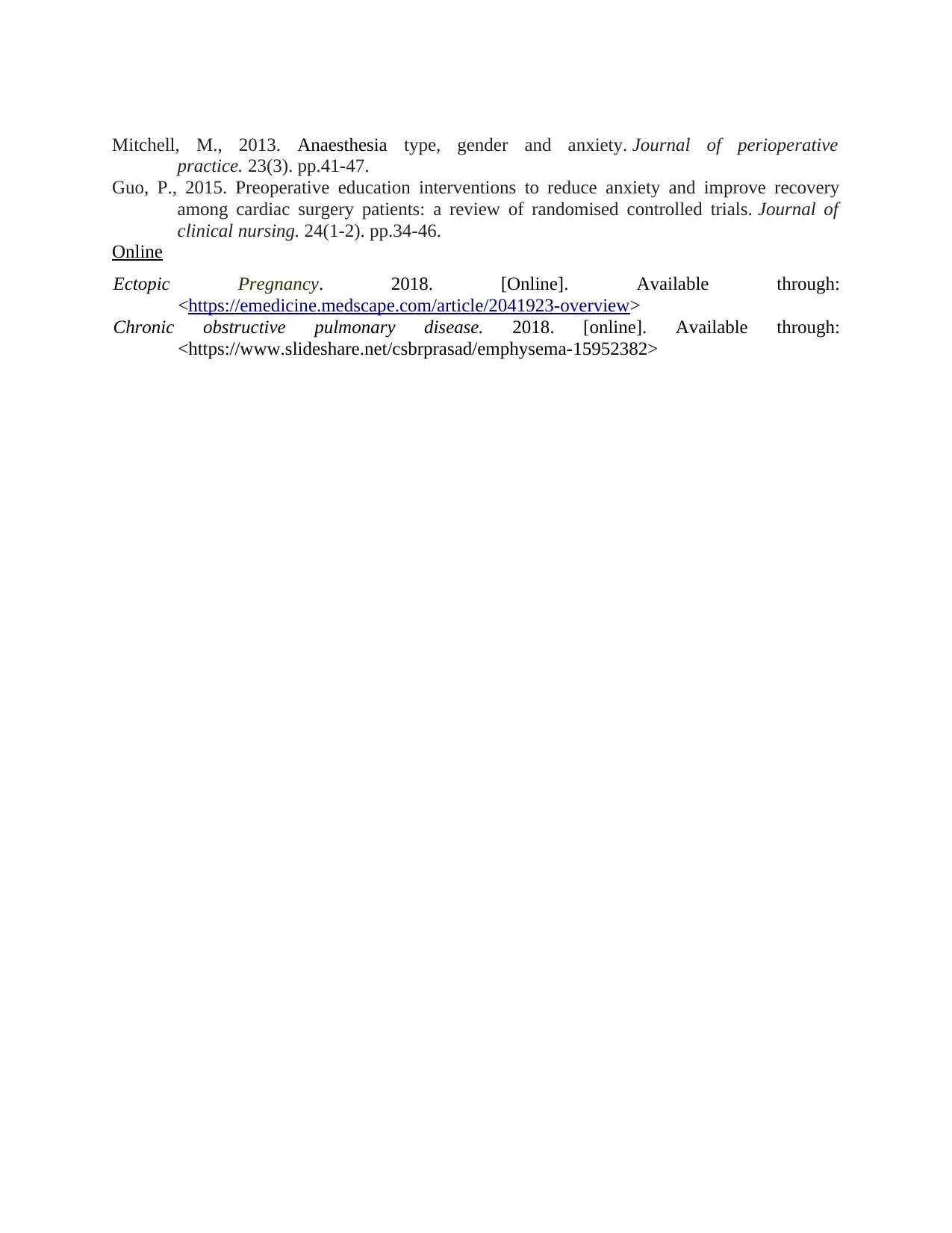
Mitchell, M., 2013. Anaesthesia type, gender and anxiety. Journal of perioperative
practice. 23(3). pp.41-47.
Guo, P., 2015. Preoperative education interventions to reduce anxiety and improve recovery
among cardiac surgery patients: a review of randomised controlled trials. Journal of
clinical nursing. 24(1-2). pp.34-46.
Online
Ectopic Pregnancy. 2018. [Online]. Available through:
<https://emedicine.medscape.com/article/2041923-overview>
Chronic obstructive pulmonary disease. 2018. [online]. Available through:
<https://www.slideshare.net/csbrprasad/emphysema-15952382>
practice. 23(3). pp.41-47.
Guo, P., 2015. Preoperative education interventions to reduce anxiety and improve recovery
among cardiac surgery patients: a review of randomised controlled trials. Journal of
clinical nursing. 24(1-2). pp.34-46.
Online
Ectopic Pregnancy. 2018. [Online]. Available through:
<https://emedicine.medscape.com/article/2041923-overview>
Chronic obstructive pulmonary disease. 2018. [online]. Available through:
<https://www.slideshare.net/csbrprasad/emphysema-15952382>
1 out of 13
Your All-in-One AI-Powered Toolkit for Academic Success.
+13062052269
info@desklib.com
Available 24*7 on WhatsApp / Email
![[object Object]](/_next/static/media/star-bottom.7253800d.svg)
Unlock your academic potential
© 2024 | Zucol Services PVT LTD | All rights reserved.